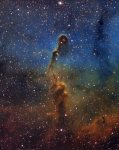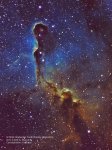I am new to NB imaging and post processing in PixInsight and have tried reading and viewing some good tutorials on YouTube about adjusting colors on a NB image but am still struggling to get the blue and gold colors as shown in the attached photo of IC1396 the Elephant Nebula (this is someone else's image). Here's my attempted post process steps using my master integrated frames;
1. Dynamic Crop to trim the edges of my SHO images.
2. Channel Combination to combine the SHO images into one RGB image.
3. Apply STF and Histogram Transformation to create a non-linear RGB image.
4. Create a Lum of the image and save it for future work.
5. Use the Color Mask script to create three masks in Green, Magenta and Cyan.
6. Use these color masks with Curves Transformation to bring out the colors of my RGB image as desired or shown in this attached photo (that is not mine).
But I am having trouble getting the blue and gold colors at the top and bottom ends of the image to appear as shown in in the attached thumbnail photo.
Can someone please provide me some suggestions or steps I need to follow to mimic the colors in this attached photo?
Here's the location of my three SHO files:
 drive.google.com
drive.google.com
Thanks for any help, Bob
1. Dynamic Crop to trim the edges of my SHO images.
2. Channel Combination to combine the SHO images into one RGB image.
3. Apply STF and Histogram Transformation to create a non-linear RGB image.
4. Create a Lum of the image and save it for future work.
5. Use the Color Mask script to create three masks in Green, Magenta and Cyan.
6. Use these color masks with Curves Transformation to bring out the colors of my RGB image as desired or shown in this attached photo (that is not mine).
But I am having trouble getting the blue and gold colors at the top and bottom ends of the image to appear as shown in in the attached thumbnail photo.
Can someone please provide me some suggestions or steps I need to follow to mimic the colors in this attached photo?
Here's the location of my three SHO files:
IC1396_Masters - Google Drive
 drive.google.com
drive.google.com
Thanks for any help, Bob


